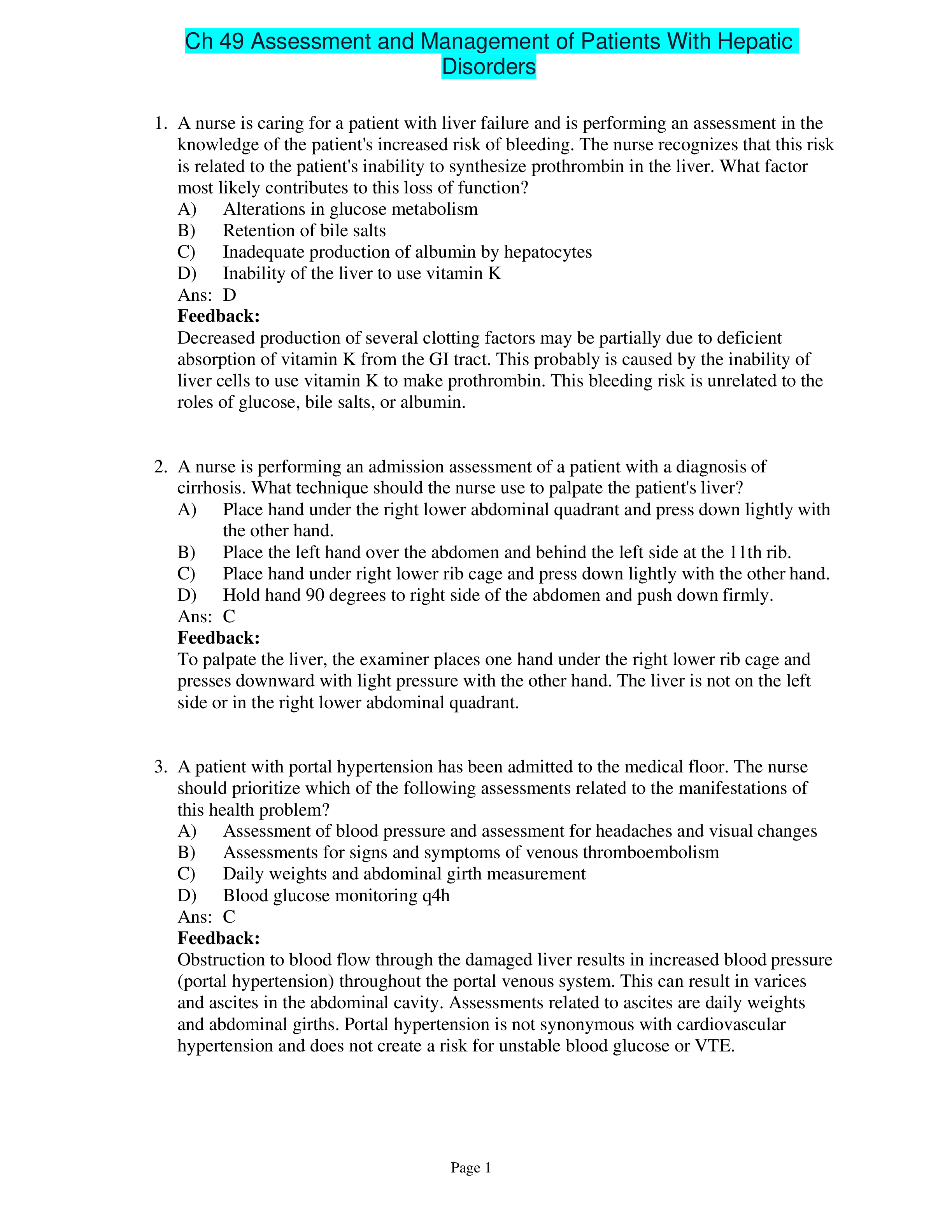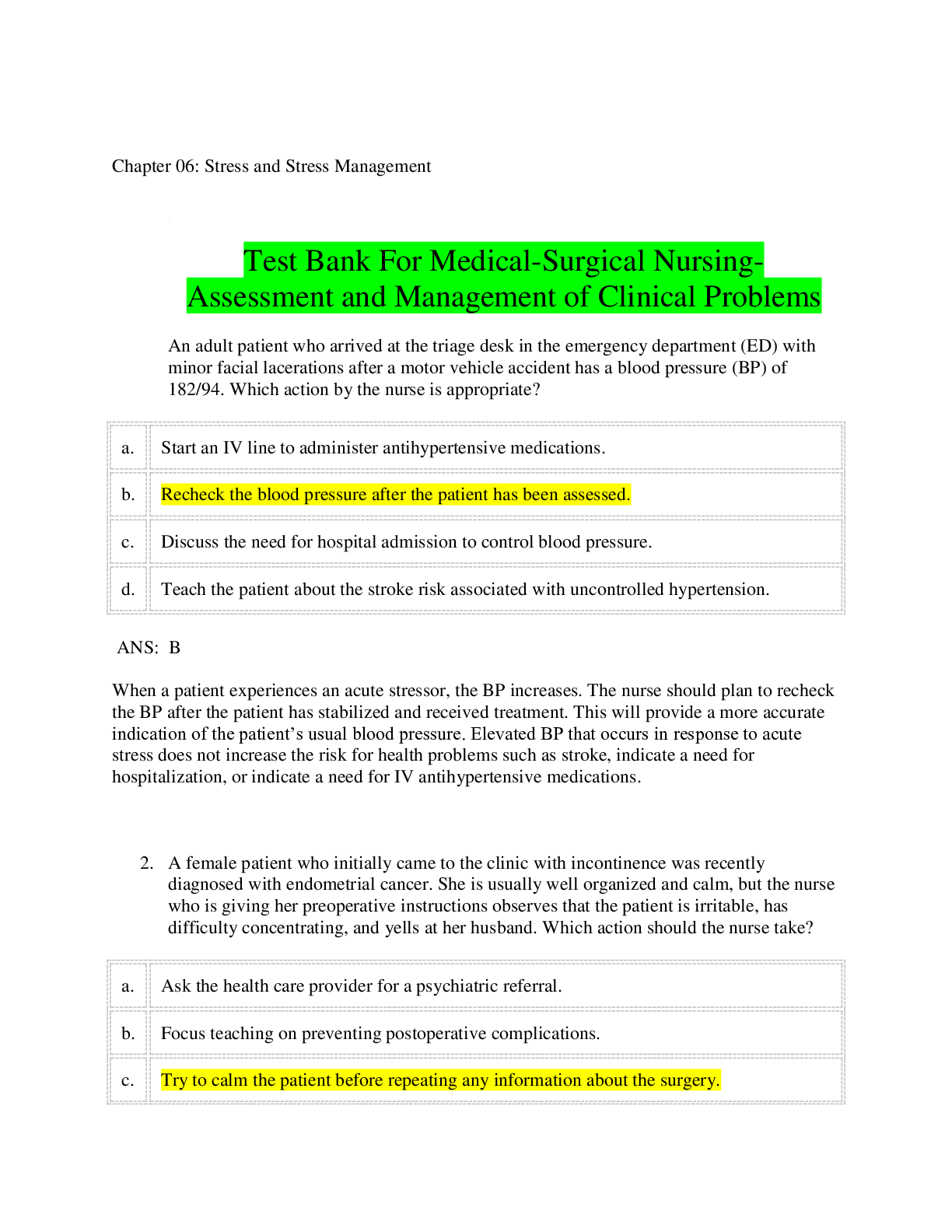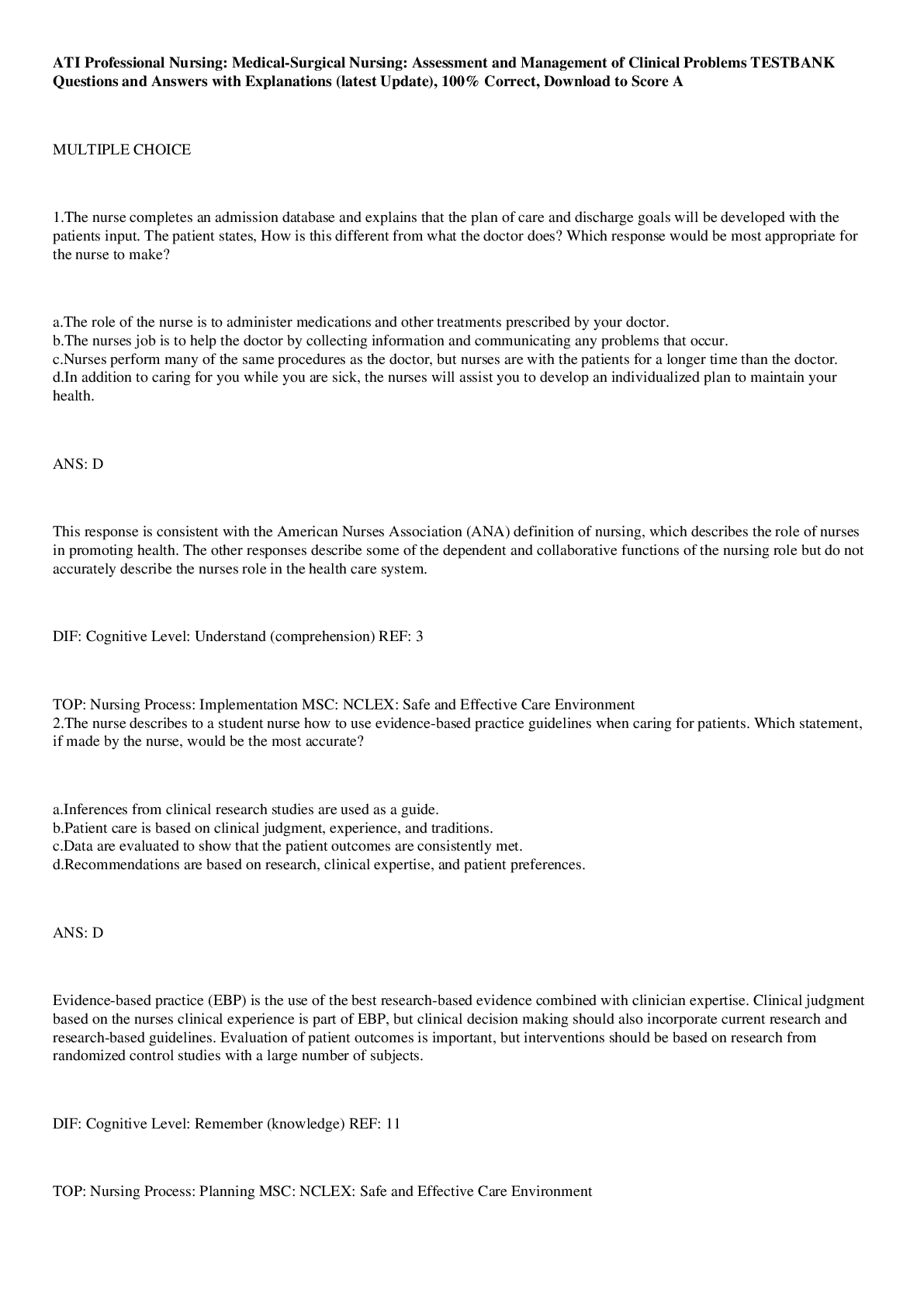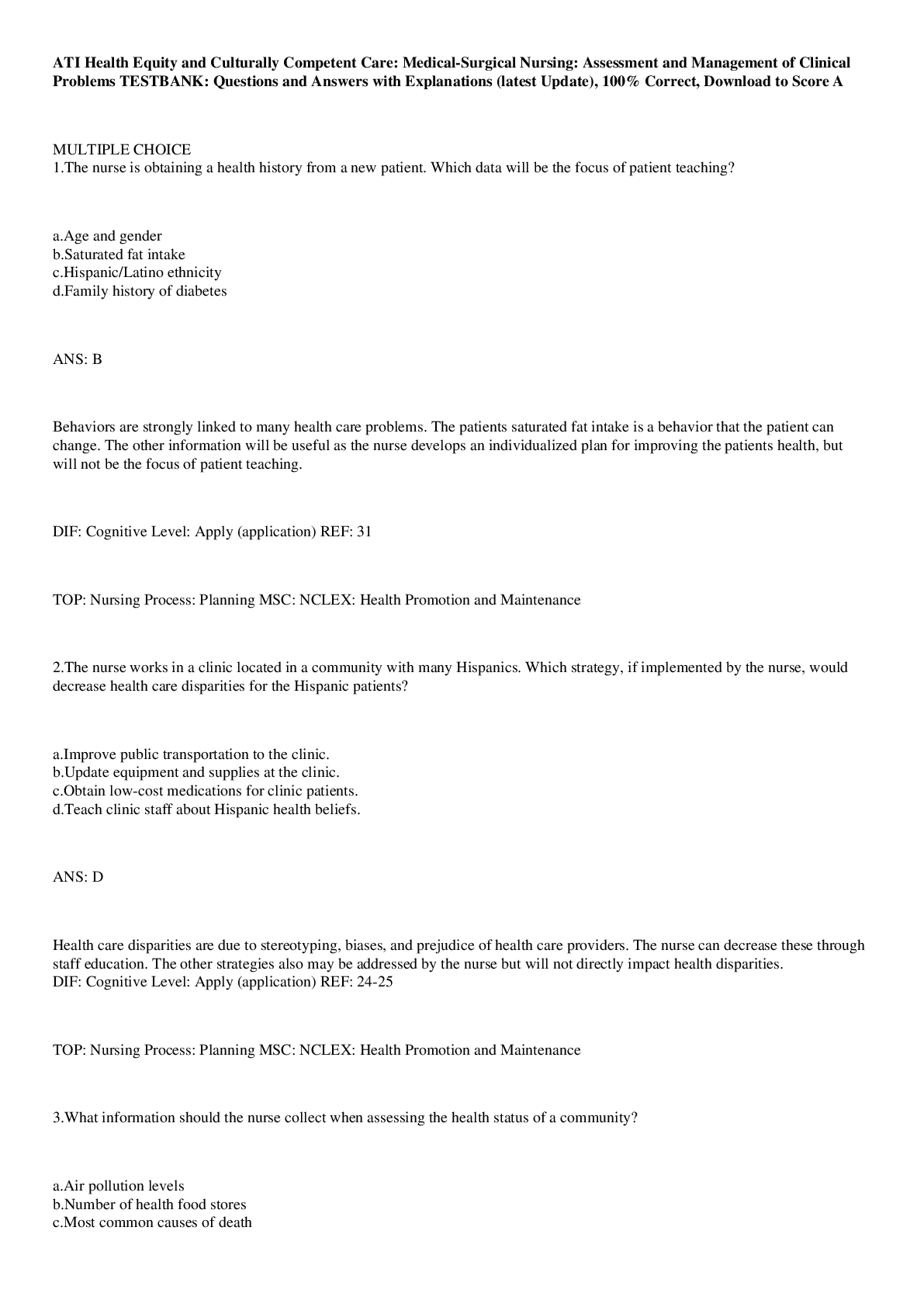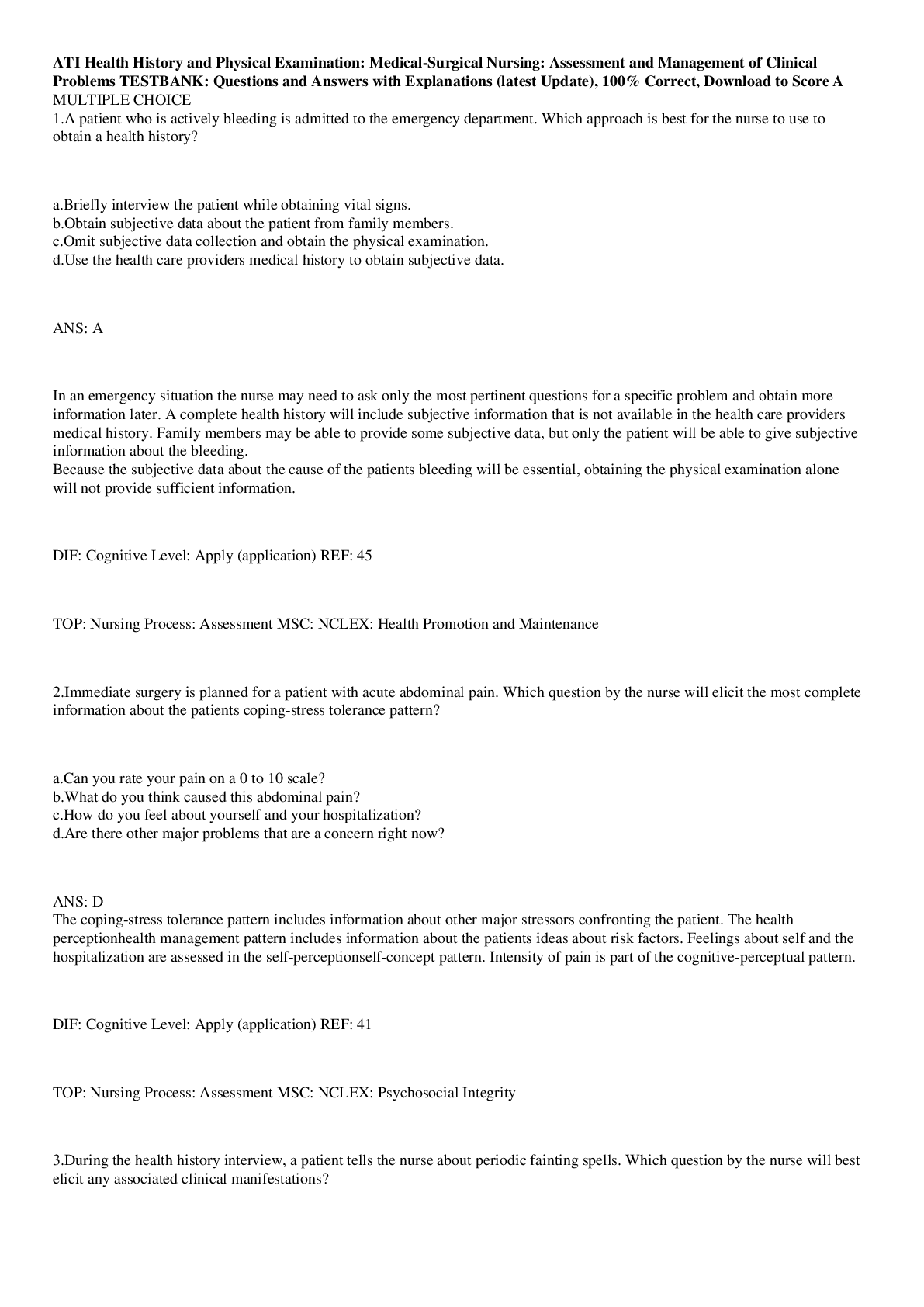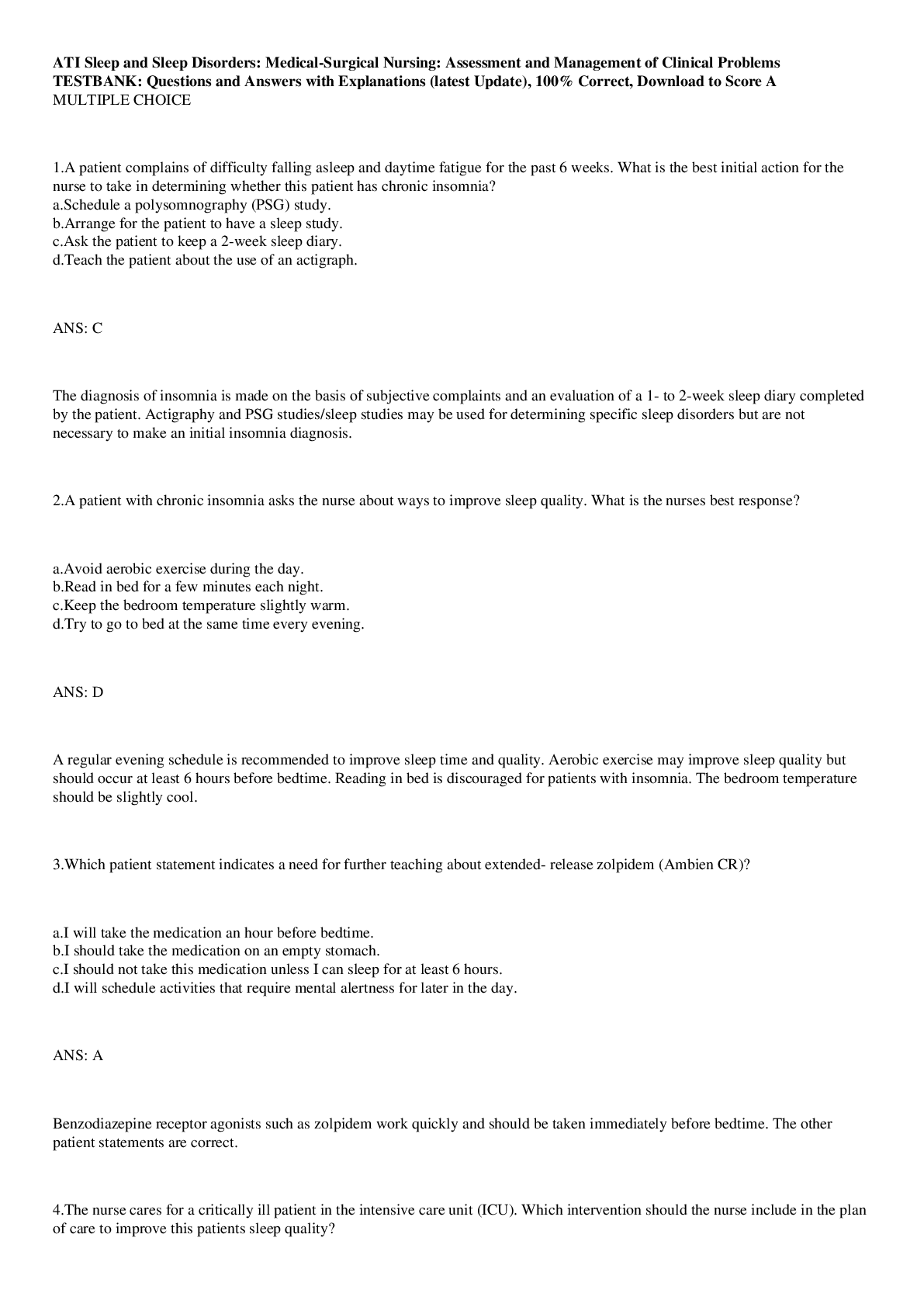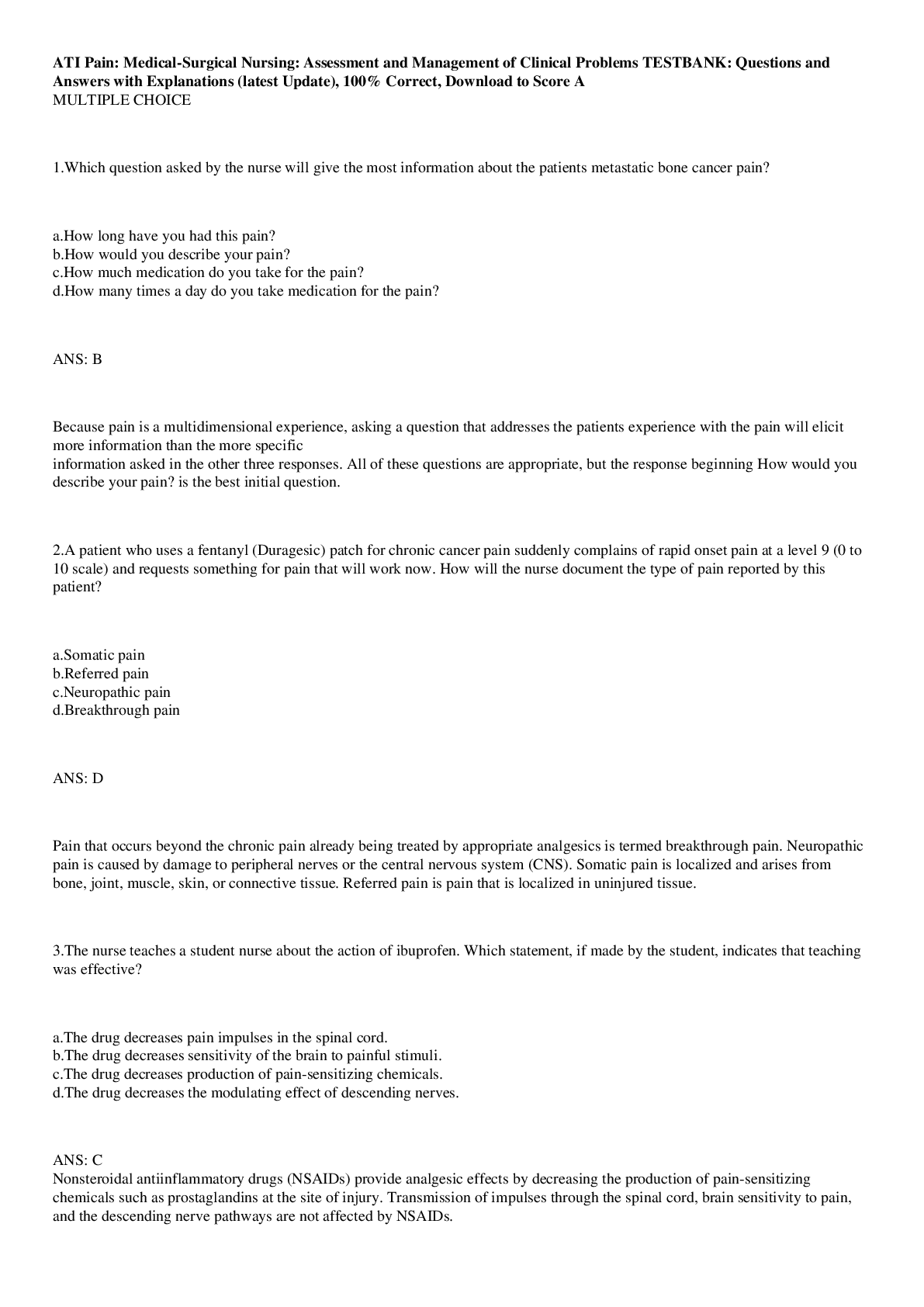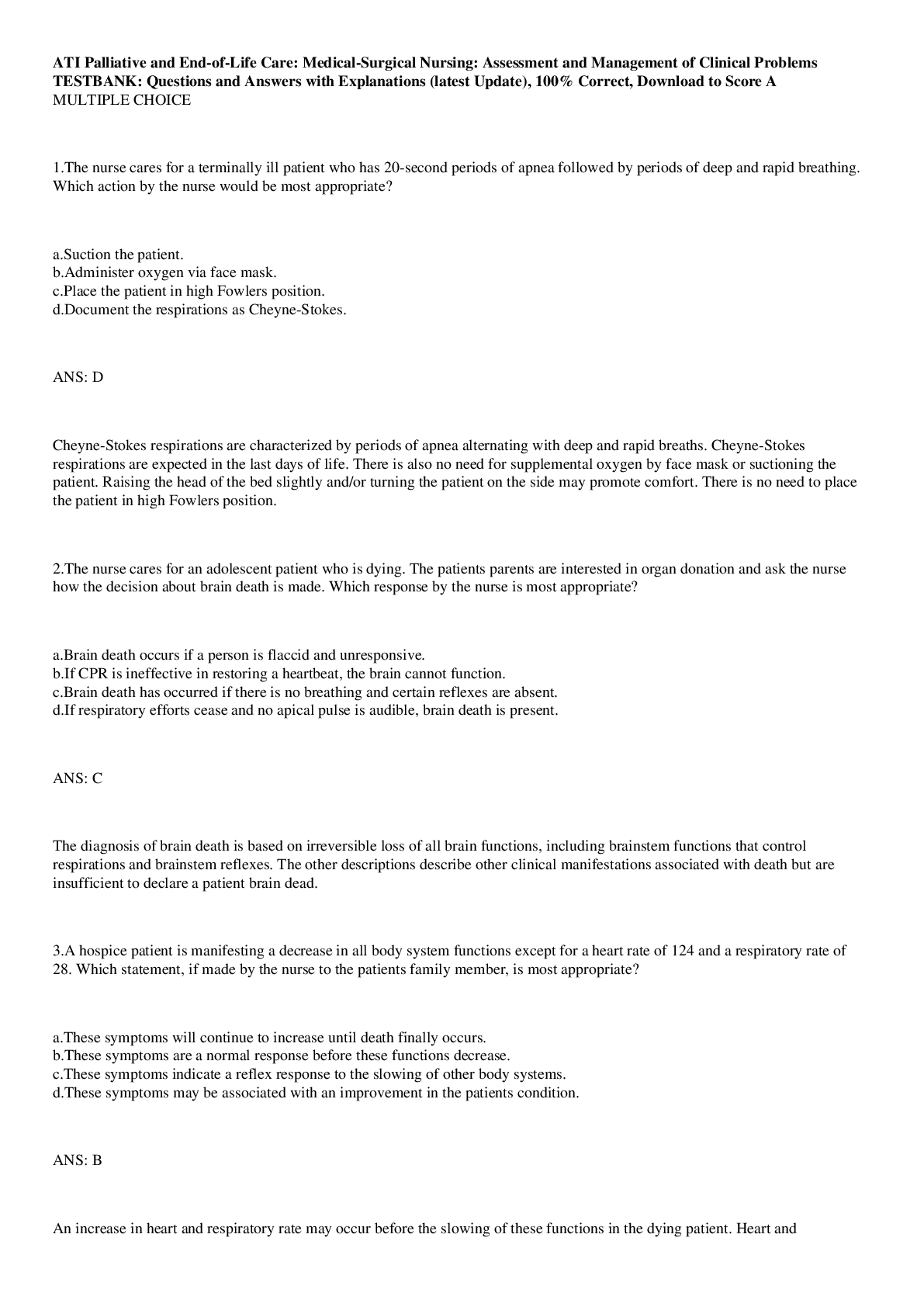*NURSING > QUESTIONS & ANSWERS > Chapter 23&24/Chapter 60&61- Assessment and management of Integumentary Function. Questions with Ac (All)
Chapter 23&24/Chapter 60&61- Assessment and management of Integumentary Function. Questions with Accurate Answers. Rated A+
Document Content and Description Below
A 38-year-old female patient states that she is using topical fluorouracil to treat actinic keratoses on her face. Which additional assessment information will be most important for the nurse to obtai... n? a. History of sun exposure by the patient b. Method of birth control used by the patient c. Length of time the patient has used fluorouracil d. Appearance of the treated areas on the patient's face - ✔✔ANS: B Because fluorouracil is teratogenic, it is essential that the patient use a reliable method of birth control. The other information is also important for the nurse to obtain, but lack of reliable birth control has the most potential for serious adverse medication effects. Note: actinic keratoses- rough scaly patch on skin that develops from sun exposure Teratogenic- disturbance of the development of embryo which will cause birth defects. Which integumentary assessment data from an older patient admitted with bacterial pneumonia is of most concern for the nurse? a. Reports a history of allergic rashes b. Scattered macular brown areas on extremities c. Skin brown and wrinkled, skin tenting on forearm d. Longitudinal nail bed ridges noted; sparse scalp hair - ✔✔ANS: A Because the patient will be receiving antibiotics to treat the pneumonia, the nurse should be most concerned about her history of allergic rashes. The nurse needs to do further assessment of possible causes of the allergic rashes and whether she has ever had allergic reactions to any drugs, especially antibiotics. The assessment data in the other response would be normal for an older patient. The nurse assesses a circular, flat, reddened lesion about 5 cm in diameter on a middle-aged patient's ankle. How should the nurse determine if the lesion is related to intradermal bleeding? a. Elevate the patient's leg. b. Press firmly on the lesion. c. Check the temperature of the skin around the lesion. d. Palpate the dorsalis pedis and posterior tibial pulses. - ✔✔ANS: B If the lesion is caused by intradermal or subcutaneous bleeding or a nonvascular cause, the discoloration will remain when direct pressure is applied to the lesion. If the lesion is caused by blood vessel dilation, blanching will occur with direct pressure. The other assessments will assess circulation to the leg, but will not be helpful in determining the etiology of the lesion. When examining an older patient in the home, the home health nurse notices irregular patterns of bruising at different stages of healing on the patient's body. Which action should the nurse take first? a. Discourage the use of throw rugs throughout the house. b. Ensure the patient has a pair of shoes with non-slip soles. c. Talk with the patient alone and ask about what caused the bruising. d. Notify the health care provider so that x-rays can be ordered as soon as possible. - ✔✔ANS: C The nurse should note irregular patterns of bruising, especially in the shapes of hands or fingers, in different stages of resolution. These may be indications of other health problems or abuse, and should be further investigated. It is important that the nurse interview the patient alone because, if mistreatment is occurring, the patient may not disclose it in the presence of the person who may be the abuser. Throw rugs and shoes with slippery surfaces may contribute to falls. X-rays may be needed if the patient has fallen recently and also has complaints of pain or decreased mobility. However, the nurse's first nursing action is to further assess the patient. A dark-skinned patient has been admitted to the hospital with chronic heart failure. How would the nurse best assess this patient for cyanosis? a. Assess the skin color of the earlobes. b. Apply pressure to the palms of the hands. c. Check the lips and oral mucous membranes. d. Examine capillary refill time of the nail beds. - ✔✔ANS: C Cyanosis in dark-skinned individuals is more easily seen in the mucous membranes. Earlobe color may change in light-skinned individuals, but this change in skin color is difficult to detect on darker skin. Application of pressure to the palms of the hands and nail bed assessment would check for adequate circulation but not for skin color. The nurse prepares to obtain a culture from a patient who has a possible fungal infection on the foot. Which items should the nurse gather for this procedure? a. Sterile gloves b. Patch test instruments c. Cotton-tipped applicators d. Local anesthetic, syringe, and intradermal needle - ✔✔ANS: C Fungal cultures are obtained by swabbing the affected area of the skin with cotton-tipped applicators. Sterile gloves are not needed because it is not a sterile procedure. Local injection is not needed because the swabbing is not usually painful. The patch test is done to determine whether a patient is allergic to specific testing material, not for obtaining fungal specimens. When performing a skin assessment, the nurse notes several angiomas on the chest of an older patient. Which action should the nurse take next? a. Assess the patient for evidence of liver disease. b. Discuss the adverse effects of sun exposure on the skin. c. Teach the patient about possible skin changes with aging. d. Suggest that the patient make an appointment with a dermatologist. - ✔✔ANS: A Angiomas are a common occurrence as patients get older, but they may occur with systemic problems such as liver disease. The patient may want to see a dermatologist to have the angiomas removed, but this is not the initial action by the nurse. The nurse may need to teach the patient about the effects of aging on the skin and about the effects of sun exposure, but the initial action should be further assessment. A patient in the dermatology clinic is scheduled for removal of a 15-mm multicolored and irregular mole from the upper back. The nurse should prepare the patient for which type of biopsy? a. Shave biopsy b. Punch biopsy c. Incisional biopsy d. Excisional biopsy - ✔✔ANS: C An incisional biopsy would remove the entire mole and the tissue borders. The appearance of the mole indicates that it may be malignant. A shave biopsy would not remove the entire mole. The mole is too large to be removed with punch biopsy. Excisional biopsies are done for smaller lesions and where a good cosmetic effect is desired, such as on the face. During assessment of the patient's skin, the nurse observes a similar pattern of small, raised lesions on the left and right upper back areas. Which term should the nurse use to document these lesions? a. Confluent b. Zosteriform c. Generalized d. Symmetric - ✔✔ANS: D The description of the lesions indicates that they are grouped. The other terms are inconsistent with the description of the lesions. A patient reports chronic itching of the ankles and continuously scratches the area. Which assessment finding will the nurse expect? a. Hypertrophied scars on both ankles b. Thickening of the skin around the ankles c. Yellowish-brown skin around both ankles d. Complete absence of melanin in both ankles - ✔✔ANS: B Lichenification is likely to occur in areas where the patient scratches the skin frequently. Lichenification results in thickening of the skin with accentuated normal skin markings. Vitiligo is the complete absence of melanin in the skin. Keloids are hypertrophied scars. Yellowish-brown skin indicates jaundice. Vitiligo, keloids, and jaundice do not usually occur as a result of scratching the skin. Which abnormality on the skin of an older patient is the priority to discuss immediately with the health care provider? a. Several dry, scaly patches on the face b. Numerous varicosities noted on both legs c. Dilation of small blood vessels on the face d. Petechiae present on the chest and abdomen - ✔✔ANS: D Petechiae are caused by pinpoint hemorrhages and are associated with a variety of serious disorders such as meningitis and coagulopathies. The nurse should contact the patient's health care provider about this finding for further diagnostic follow-up. The other skin changes are associated with aging. Although the other changes will also require ongoing monitoring or intervention by the nurse, they do not indicate a need for urgent action. When taking the health history of an older adult, the nurse discovers that the patient has worked in the landscaping business for 40 years. The nurse will plan to teach the patient about how to self-assess for which clinical manifestations (select all that apply)? a. Vitiligo b. Alopecia c. Intertrigo d. Erythema e. Actinic keratosis - ✔✔ANS: D, E A patient who has worked as a landscaper is at risk for skin lesions caused by sun exposure such as erythema and actinic keratosis. Vitiligo, alopecia, and intertrigo are not associated with excessive sun exposure. Which activities can the nurse working in the outpatient clinic delegate to a licensed practical/vocational nurse (LPN/LVN) (select all that apply)? a. Administer patch testing to a patient with allergic dermatitis. b. Interview a new patient about chronic health problems and allergies. c. Apply a sterile dressing after the health care provider excises a mole. d. Teach a patient about site care after a punch biopsy of an upper arm lesion. e. Explain potassium hydroxide testing to a patient with a superficial skin infection. - ✔✔ANS: A, C Skills such as administration of patch testing and sterile dressing technique are included in LPN/LVN education and scope of practice. Obtaining a health history and patient education require more critical thinking and registered nurse (RN) level education and scope of practice. A nurse is aware that the outer layer of the skin consists of dead cells that contain large amounts of keratin. The physiologic functions of keratin include which of the following? Select all that apply. A) Producing antibodies B) Absorbing electrolytes C) Maintaining acidñbase balance D) Physically repelling pathogens E) Preventing fluid loss - ✔✔Ans: D, E Feedback: The dead cells of the epidermis contain large amounts of keratin, an insoluble, fibrous protein that forms the outer barrier of the skin. Keratin has the capacity to repel pathogens and prevent excessive fluid loss from the body. It does not contribute directly to antibody production, acidñbase balance, or electrolyte levels. When planning the skin care of a patient with decreased mobility, the nurse is aware of the varying thickness of the epidermis. At what location is the epidermal layer thickest? A) The scalp B) The elbows C) The palms of the hands D) The knees - ✔✔Ans: C Feedback: The epidermis is the thickest over the palms of the hands and the soles of the feet. A young student is brought to the school nurse after falling off a swing. The nurse is documenting that the child has bruising on the lateral aspect of the right arm. What term will the nurse use to describe bruising on the skin in documentation? A)Telangiectasias B)Ecchymoses C)Purpura D)Urticaria - ✔✔Ans: B Feedback: Telangiectasias consists of red marks on the skin caused by stretching of superficial blood vessels. Ecchymoses are bruises, and purpura consists of pinpoint hemorrhages into the skin. Urticariais wheals or hives. The nurse in an ambulatory care center is admitting an older adult patient who has bright red moles on the skin. Benign changes in elderly skin that appear as bright red moles are termed what? A) Cherry angiomas B) Solar lentigo C) Seborrheickeratoses D) Xanthelasma - ✔✔Ans: A Feedback: Cherry angiomas appear as bright red ìmoles,î while solar lentigo are commonly called ìliver spots.î Seborrheickeratoses are described as crusty brown ìstuck onî patches, while xanthelasma appears as yellowish, waxy deposits on the upper eyelids. While assessing a dark-skinned patient at the clinic, the nurse notes the presence of patchy, milky white spots. The nurse knows that this finding is characteristic of what diagnosis? A) Cyanosis B) Addison's disease C) Polycythemia D) Vitiligo - ✔✔Ans:D Feedback: With cyanosis, nail beds are dusky. With polycythemia, the nurse notes ruddy blue face, oral mucosa, and conjunctiva. A bronzed appearance, or ìexternal tan,î is associated with Addison's disease. Vitiligo is a condition characterized by destruction of the melanocytes in circumscribed areas of skin and appears in light or dark skin as patchy, milky white spots, often symmetric bilaterally. While waiting to see the physician, a patient shows the nurse skin areas that are flat, nonpalpable, and have had a change of color. The nurse recognizes that the patient is demonstrating what? A) Macules B) Papules C) Vesicles D) Pustules - ✔✔Ans: A Feedback: A macule is a flat, nonpalpable skin color change, while a papule is an elevated, solid, palpable mass. A vesicle is a circumscribed, elevated, palpable mass containing serous fluid, while a pustule is a pus-filled vesicle. An African American is admitted to the medical unit with liver disease. To correctly assess this patient for jaundice, on what body area should the nurse look for yellow discoloration? A) Elbows B) Lips C) Nail beds D) Sclerae - ✔✔Ans: D Feedback: Jaundice, a yellowing of the skin, is directly related to elevations in serum bilirubin and is often first observed in the sclerae and mucous membranes. A nurse is doing a shift assessment on a group of patients after first taking report. An elderly patient is having her second dose of IV antibiotics for a diagnosis of pneumonia. The nurse notices a new rash on the patient's chest. The nurse should ask what priority question regarding the presence of a reddened rash? A) ìIs the rash worse at a particular time or season?î B) ìAre you allergic to any foods or medication?î C) ìAre you having any loss of sensation in that area?î D) ìIs your rash painful?î - ✔✔ANS: B Feedback: The nurse should suspect an allergic reaction to the antibiotic therapy. Allergies can be a significant threat to the patient's immediate health, thus questions addressing this possibility would be prioritized over those addressing sensation. Asking about previous rashes is important, but this should likely be framed in the context of an allergy assessment. A gerontologic nurse is teaching a group of nursing students about integumentary changes that occur in older adults. How should these students best integrate these changes into care planning? A) By avoiding the use of moisturizing lotions on older adults' skin B) By protecting older adults against shearing injuries C) By avoiding the use of ice packs to treat muscle pain D) By protecting older adults against excessive sweat accumulation - ✔✔Ans: B Feedback: Cellular changes associated with aging include thinning at the junction of the dermis and epidermis, which creates a risk for shearing injuries. Moisturizing lotions can be safely used to address the increased dryness of older adults' skin. Ice packs can be used, provided skin is assessed regularly and the patient possesses normal sensation. Older adults perspire much less than younger adults, thus sweat accumulation is rarely an issue. A patient is diagnosed with atrial fibrillation and the physician orders Coumadin (warfarin). For what skin lesion should the nurse monitor this patient? A) Ulcer B) Ecchymosis C) Scar D) Erosion - ✔✔Ans: B Feedback: Ecchymosis refers to a round or irregular macular lesion, which is larger than petechiae. This occurs secondary to blood extravasation. It is important to watch for ecchymosis in a patient receiving any type of anticoagulant. An ulcer is an open lesion eroded into the patient's flesh. A scar is an area on the skin caused by the healing of an injury. Erosion is loss of superficial epidermis that does not extend to the dermisóa depressed, moist area. A new patient has come to the dermatology clinic to be assessed for a reddened rash on his abdomen. What diagnostic test would most likely be ordered to identify the causative allergen? A) Skin scrapings B) Skin biopsy C) Patch testing D) Tzanck smear - ✔✔Ans: C Feedback: Patch testing is performed to identify substances to which the patient has developed an allergy. Skin scrapings are done for suspected fungal lesions. A skin biopsy is completed to rule out malignancy and to establish an exact diagnosis of skin lesions. A Tzanck smear is used to examine cells from blistering skin conditions, such as herpes zoster. A patient with a suspected malignant melanoma is referred to the dermatology clinic. The nurse knows to facilitate what diagnostic test to rule out a skin malignancy? A) Tzanck smear B) Skin biopsy C) Patch testing D) Skin scrapings - ✔✔Ans: B Feedback: A skin biopsy is done to rule out malignancies of skin lesions. A Tzanck smear is used to examine cells from blistering skin conditions, such as herpes zoster. Patch testing is performed to identify substances to which the patient has developed an allergy. Skin scrapings are done for suspected fungal infections. A nurse is explaining the importance of sunlight on the skin to a woman with decreased mobility who rarely leaves her house. The nurse would emphasize that ultraviolet light helps to synthesize what vitamin? A) E B) D C) A D) C - ✔✔Ans: B Feedback: Skin exposed to ultraviolet light can convert substances necessary for synthesizing vitamin D (cholecalciferol). Vitamin D is essential for preventing rickets, a condition that causes bone deformities and results from a deficiency of vitamin D, calcium, and phosphorus. A nurse is working with a patient who has a diagnosis of Cushing syndrome. When completing a physical assessment, the nurse should specifically observe for what integumentary manifestation? A) Alopecia B) Yellowish skin tone C) Patchy, bronze pigmentation D) Hirsutism - ✔✔Ans: D Feedback: Cushing syndrome causes excessive hair growth, especially in women. Alopecia is hair loss from the scalp and other parts of the body. Jaundice causes a yellow discoloration in light-skinned patients, but this does not accompany Cushing syndrome. Patients that have Addison's disease exhibit a bronze discoloration to their skin due to increased melanin production. The outer layer of the epidermis provides the most effective barrier to penetration of the skin by environmental factors. Which of the following is an example of penetration by an environmental factor? A) An insect bite B) Dehydration C) Sunburn D) Excessive perspiration - ✔✔Ans: A Feedback: The stratum corneum, the outer layer of the epidermis, provides the most effective barrier to both epidermal water loss and penetration of environmental factors, such as chemicals, microbes, insect bites, and other trauma. Dehydration, sunburn, and excessive perspiration are not examples of penetration of an environmental factor. A nurse in a dermatology clinic is reading the electronic health record of a new patient. The nurse notes that the patient has a history of a primary skin lesion. What is an example of a primary skin lesion? A) Crust B) Keloid C) Pustule D) Ulcer - ✔✔Ans: C Feedback: A pustule is an example of a primary skin lesion. Primary skin lesions are original lesions arising from previously normal skin. Crusts, keloids and ulcers are secondary lesions. An unresponsive Caucasian patient has been brought to the emergency room by EMS. While assessing this patient, the nurse notes that the patient's face is a cherry-red color. What should the nurse suspect? A) Carbon monoxide poisoning B) Anemia C) Jaundice D) Uremia - ✔✔Ans:A Feedback: Carbon monoxide poisoning causes a bright cherry red color in the face and upper torso in light-skinned persons. In dark-skinned persons, there will be a cherry red color to nail beds, lips, and oral mucosa. When anemia occurs in light-skinned persons, the skin has generalized pallor. Anemia in dark-skinned persons manifests as a yellow-brown coloration. Jaundice appears as a yellow coloration of the sclerae. Uremia gives a yellow-orange tinge to the skin. - ✔✔Ans: D Feedback: Melanocytes are the special cells of the epidermis that are primarily responsible for producing the pigment melanin. Islets of Langerhans are clusters of cells in the pancreas. Squamous cells are flat, scaly epithelial cells. T cells function in the immune response. A wound care nurse is reviewing skin anatomy with a group of medical nurses. Which area of the skin would the nurse identify as providing a cushion between the skin layers, muscles, and bones? A) Dermis B) Subcutaneous tissue C) Epidermis D) Stratum corneum - ✔✔Ans: B Feedback: The subcutaneous tissue, or hypodermis, is the innermost layer of the skin that is responsible for providing a cushion between the skin layers, muscles, and bones. The dermis is the largest portion of the skin, providing strength and structure. The epidermis is the outermost layer of stratified epithelial cells and composed of keratinocytes. The stratum corneum is the outermost layer of the epidermis, which provides a barrier to prevent epidermal water loss. A young student comes to the school nurse and shows the nurse a mosquito bite. As the nurse expects, the bite is elevated and has serous fluid contained in the dermis. How would the nurse classify this lesion? A) Vesicle B) Macule C) Nodule D) Wheal - ✔✔Ans: D Feedback: A wheal is a primary skin lesion that is elevated and has fluid contained in the dermis. An example of a wheal would be an insect bite or hives. Vesicles, macules, and nodules are not characterized by elevation and the presence of serous fluid. While assessing a 25-year-old female, the nurse notes that the patient has hair on her lower abdomen. Earlier in the health interview, the patient stated that her menses are irregular. The nurse should suspect what type of health problem? A) A metabolic disorder B) A malignancy C) A hormonal imbalance D) An infectious process - ✔✔Ans: C Feedback: Some women with higher levels of testosterone have hair in the areas generally thought of as masculine, such as the face, chest, and lower abdomen. This is often a normal genetic variation, but if it appears along with irregular menses and weight changes, it may indicate a hormonal imbalance. This combination of irregular menses and hair distribution is inconsistent with metabolic disorders, malignancy, or infection. An 82-year-old patient is being treated in the hospital for a sacral pressure ulcer. What age-related change is most likely to affect the patient's course of treatment? A) Increased thickness of the subcutaneous skin layer B) Increased vascular supply to superficial skin layers C) Changes in the character and quantity of bacterial skin flora D) Increased time required for wound healing - ✔✔Ans: D Feedback: Wound healing becomes slower with age, requiring more time for older adults to recover from surgical and traumatic wounds. There are no changes in skin flora with increased age. Vascular supply and skin thickness both decrease with age. A nurse is preparing to perform the physical assessment of a newly admitted patient. During which of the following components of the assessment should the nurse wear gloves? Select all that apply. A) Palpation of the patient's scalp B) Palpation of the patient's upper extremities C) Palpation of a rash on the patient's trunk D) Palpation of a lesion on the patient's upper back E) Palpation of the patient's fingers - ✔✔Ans: C, D Feedback: Gloves are worn during skin examination if a rash or lesions are to be palpated. It is not normally necessary to wear gloves to palpate a patient's scalp, extremities, or fingers unless contact with body fluids is reasonably foreseeable. [Show More]
Last updated: 1 year ago
Preview 1 out of 43 pages
Instant download
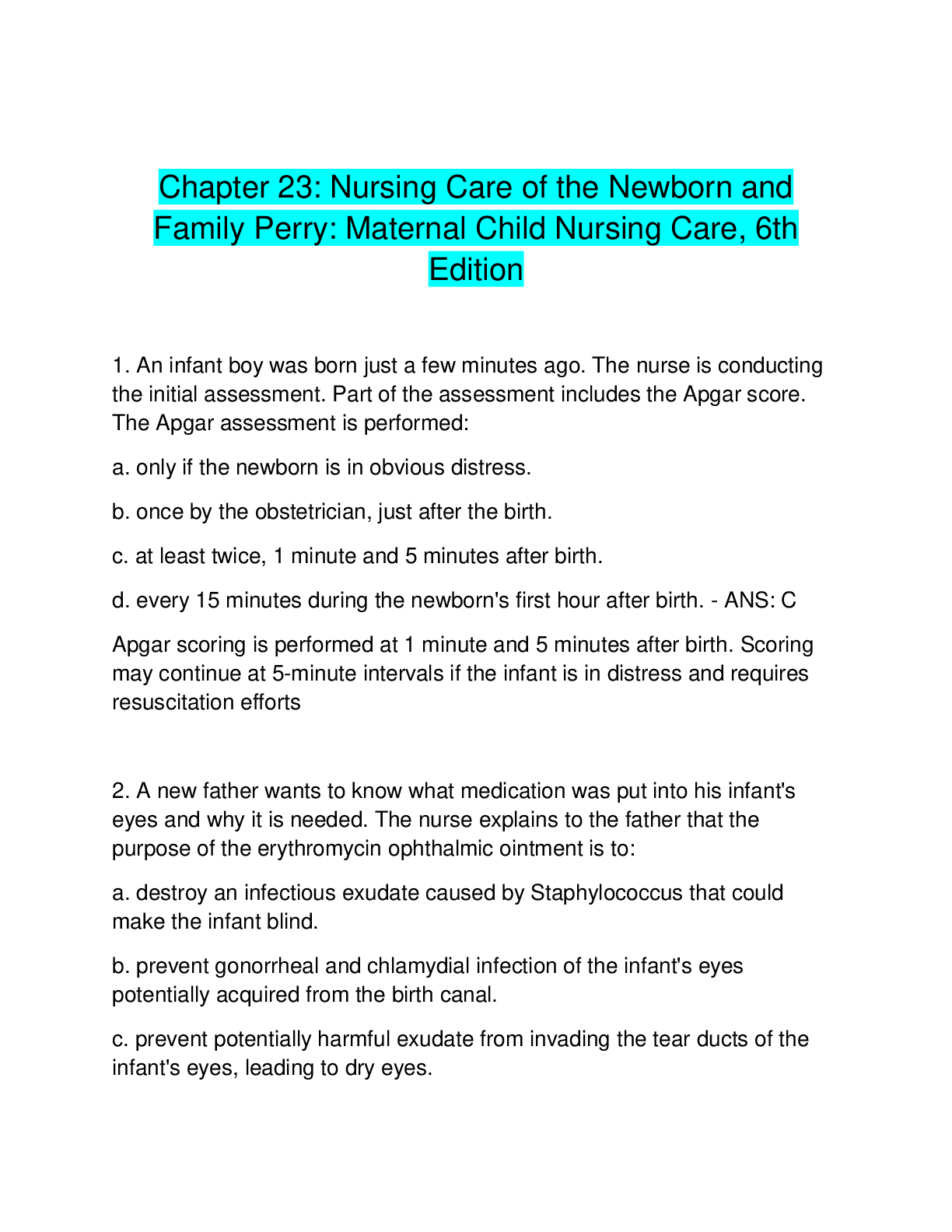
Buy this document to get the full access instantly
Instant Download Access after purchase
Add to cartInstant download
Reviews( 0 )
Document information
Connected school, study & course
About the document
Uploaded On
Aug 12, 2022
Number of pages
43
Written in
Additional information
This document has been written for:
Uploaded
Aug 12, 2022
Downloads
0
Views
67












